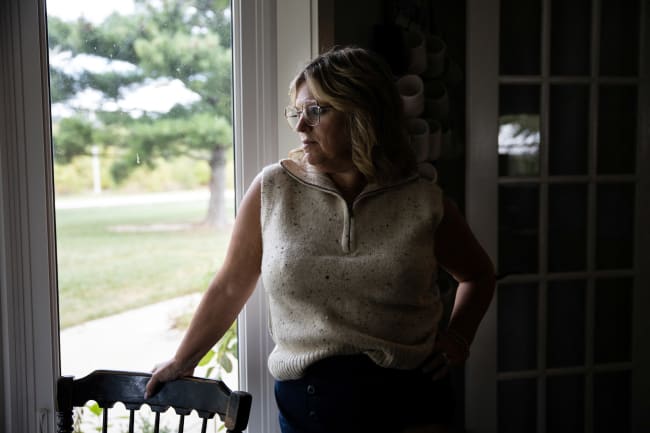Coughs and sneezes are sounding across the United States as cold weather ushers in respiratory illness. The fall and winter viral season, which runs from October to April, presents the greatest risk of hospitalization for babies. The U.S. Centers for Disease Control and Prevention (CDC) projects that this season will be as bad as last year, which at its peak caused about 100 hospitalizations for every 100,000 babies due to respiratory syncytial virus (RSV) alone.
As parents contemplate the best plan to prevent their newborns from falling ill, epidemiologist Katherine Ahrens at the University of Southern Maine believes that one answer lies in a workplace policy that's determined by the state.
In August, Ahrens published a study examining the effect of New York's 2018 paid family leave (PFL) program on infant health. She and her team found that after the state introduced mandatory PFL, hospitals saw an 18% reduction in respiratory infection cases for infants younger than 8 weeks old. The findings mirror a California study that linked PFL initiatives with a 33% drop in infant upper-respiratory infections.
The results, released in JAMA Pediatrics, are a clear sign in a growing body of research that PFL can and does improve infant health outcomes in the states that mandate it, Ahrens said.
The United States is the only high-income country where federal law does not guarantee workers paid time off. The Family and Medical Leave Act, a 31-year-old law regulating employment and time off, provides unpaid leave only for eligible employees.
The desire for federal paid leave has garnered extensive bipartisan support this election cycle. In a recent poll conducted by YouGov for Glamour, 89% of Democrat-leaning and 68% of Republican-leaning women voters felt that paid leave was an important issue. The Harris-Walz party is campaigning for national paid leave; as governor, Walz has already approved a PFL bill in his state, Minnesota. During his presidency, Donald Trump proposed a paid parental leave budget for federal workers, and his running mate Senator JD Vance is currently voicing support for paid leave programs. Broader nationwide proposals have advanced through the Build Back Better Act, though no federal paid leave has yet to be instated.
Because national protection falls short, paid leave policies are left to state governments, and a patchwork exists across the country. California passed a PFL program that became effective in 2004; New Jersey later followed suit with their own version in 2009. A total of 13 states and the District of Columbia have now enacted mandatory PFL policies; an additional nine have a voluntary version.
Each program varies depending on the state, including job-protection rights, the number of weeks off, and what percentage of one's income is granted to them while not working. In general, the state laws tend to be more generous than the Family and Medical Leave Act.
States with protected PFL also tend to be those with lower proportions of infant respiratory infection rates. Positive RSV cases are highest in the South and south Atlantic regions of the country. According to the CDC, states such as Florida, Georgia, Louisiana, Tennessee, and Texas had elevated rates of RSV.
Studies have even shown lower likelihoods of maternal and infant rehospitalization due to infections. PFL states also have an uptick in early-stage breastfeeding relative to non-PFL states—which could protect against respiratory tract infections for babies less than a year old.
Mandatory PFL is designed to cover as many employees in the state as possible, said Molly Weston Williamson, a senior fellow at the Center for American Progress. It includes workers in industries less likely to have access to paid leave programs, part-time employees, and low-income individuals. New York's program, for instance, covered roughly 8 million workers across a range of industries in 2022.
These programs tend to be well used. In New York, more than 2% of eligible workers used that program. Massachusetts approved applications for 117,000 people, and Washington paid $1.3 billion to more than 173,000 workers.
However, "outside of those 13 states, access to paid leave is effectively in the hands of the employers," said Maya Rossin-Slater, an associate professor of health policy at Stanford University. Only 27% of the private-sector workforce has access to paid leave from their employers.
Rossin-Slater added that for workers in the bottom 10% of that private-sector wage distribution, "less than 5% of them have access to paid leave from their employers. It's much higher for workers in the top 10% of the wage distribution."
An employee's access to paid leave is cause for concern: The CDC recently published an article stating that some risk factors for RSV infection during infancy include whether the family lives in a neighborhood below the poverty line. This research suggests that cases of infant respiratory infections may be more prevalent among lower-income families. Of the poorest states, such as Mississippi and Louisiana, most have either no paid leave program or a voluntary one. Experts state this correlation could be due to putting young children in group care early because the parent works.
Clinical and health policy experts agree that more widespread PFL implementation is needed
"[Because] the transmission of these viruses is enhanced by crowding . . . it stands to reason that people who are less economically advantaged and live closer together in smaller quarters have more illness and, as a consequence, more hospitalizations due to these viral infections," said William Schaffner, who serves as a clinician and epidemiologist of infectious diseases at Vanderbilt University School of Medicine. If paid leave were available, Schaffner reasoned that parents could take time off during infection seasons and reduce the risk of transmitting illnesses to their infant.
But knowing who actually accesses PFL programs is still murky. Several states do not have a centralized database to measure inequities in uptake. Details about people who qualify but do not take advantage of PFL remain unclear. Few surveys ask this question and fewer still follow up with concrete demographics, including race-ethnicity, income, or type of job.
Nonetheless, clinical and health policy experts agree that more widespread PFL implementation is needed. Schaffner, on learning of PFL's buffer effect on infant hospitalizations, felt that the notion was "provocative" for the conversation around the law.
Southern states most at risk for higher rates of infant respiratory infections are also working on mandatory paid leave laws behind the scenes. Georgia, South Carolina, and Tennessee are working toward passing public-sector PFL policies.
In the meantime, preventative measures for respiratory infections include early vaccinations and staying home with the baby if you can afford it.
"If we allow families to have a parent or a caregiver that can stay home with the child in those first few weeks and months of life," Rossin-Slater said, "we can avert many more hospitalizations for respiratory issues for these babies."













